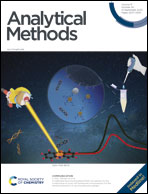Double protein directed synthesis of chemically etched sulfur doped quantum dots for signal “on–off–on” sensing of glutathione mediated by copper ions†
Abstract
In this study, a novel “on–off–on” fluorescent probe was suggested for sensitive and selective assay of glutathione (GSH). The as-fabricated nanoswitch employs a Cu2+–sulfur quantum dot system (SQ-dots/Cu2+). The surface reactivity and water solubility of SQ-dots were improved through capping with egg white and bovine serum albumin proteins. The surface functional groups on the surface of double protein-protected SQ-dots enhanced the interaction with Cu2+ ions, resulting in the aggregation induced quenching of SQ-dots. Addition of GSH, a strong Cu2+ ion chelator, disassembles the large aggregates into relatively smaller ones, restoring the fluorescence emission of SQ-dots. Under optimized conditions, the fluorescence intensity was increased by increasing GSH amounts within the range of 0.13–550 μM with a detection limit (S/N = 3) of 0.04 μM. The SQ-dots/Cu2+ system was successfully applied for the detection of GSH in different matrices such as dietary supplements, human serum, and vegetable extract samples. The as-fabricated probe holds great potential for the synthesis of other functionalized SQ-dots for (bio) sensing.



 Please wait while we load your content...
Please wait while we load your content...